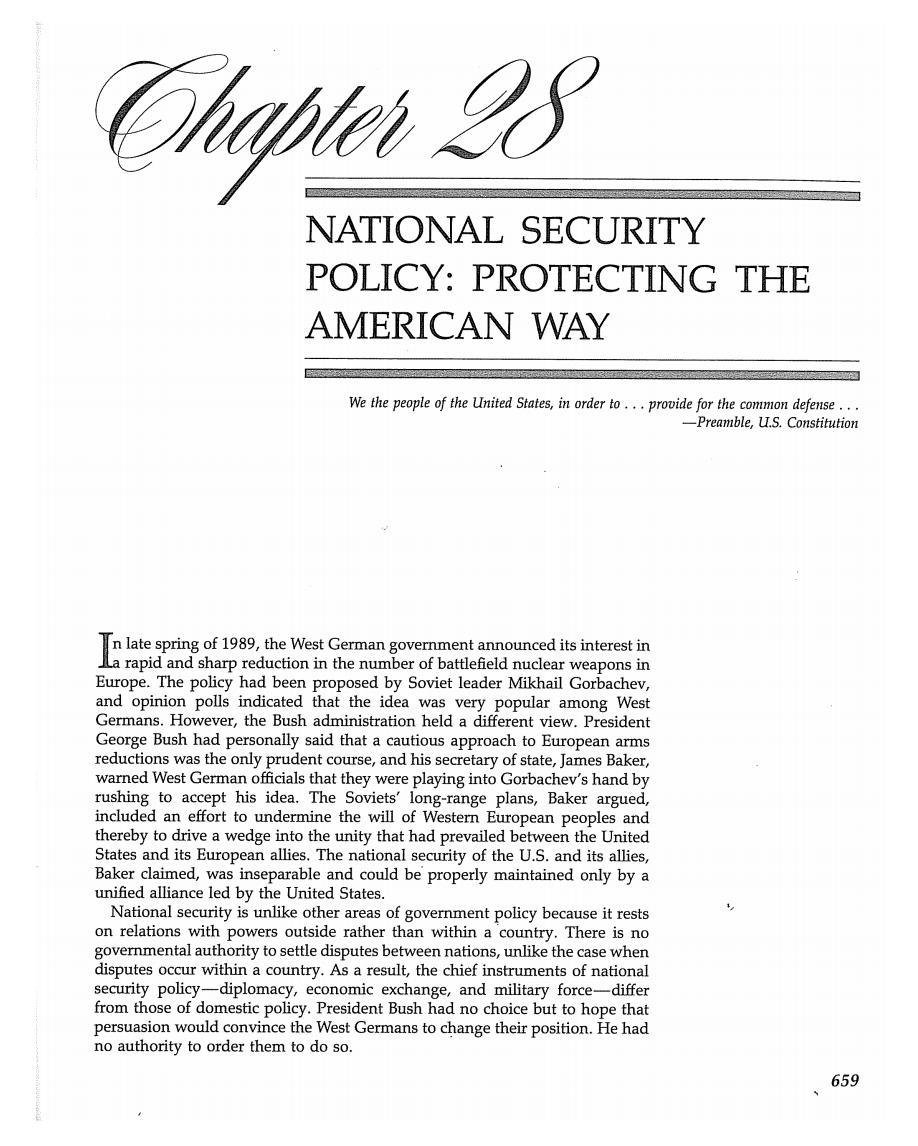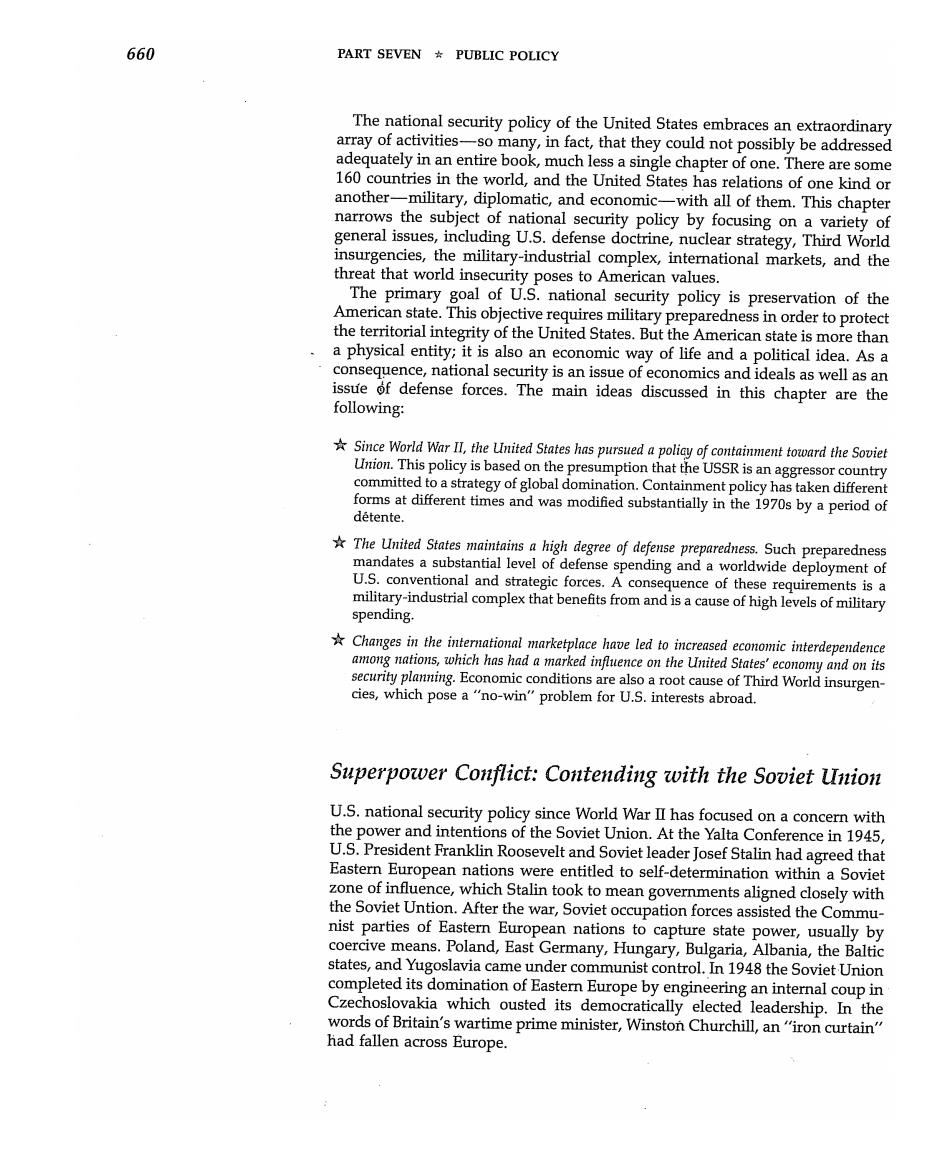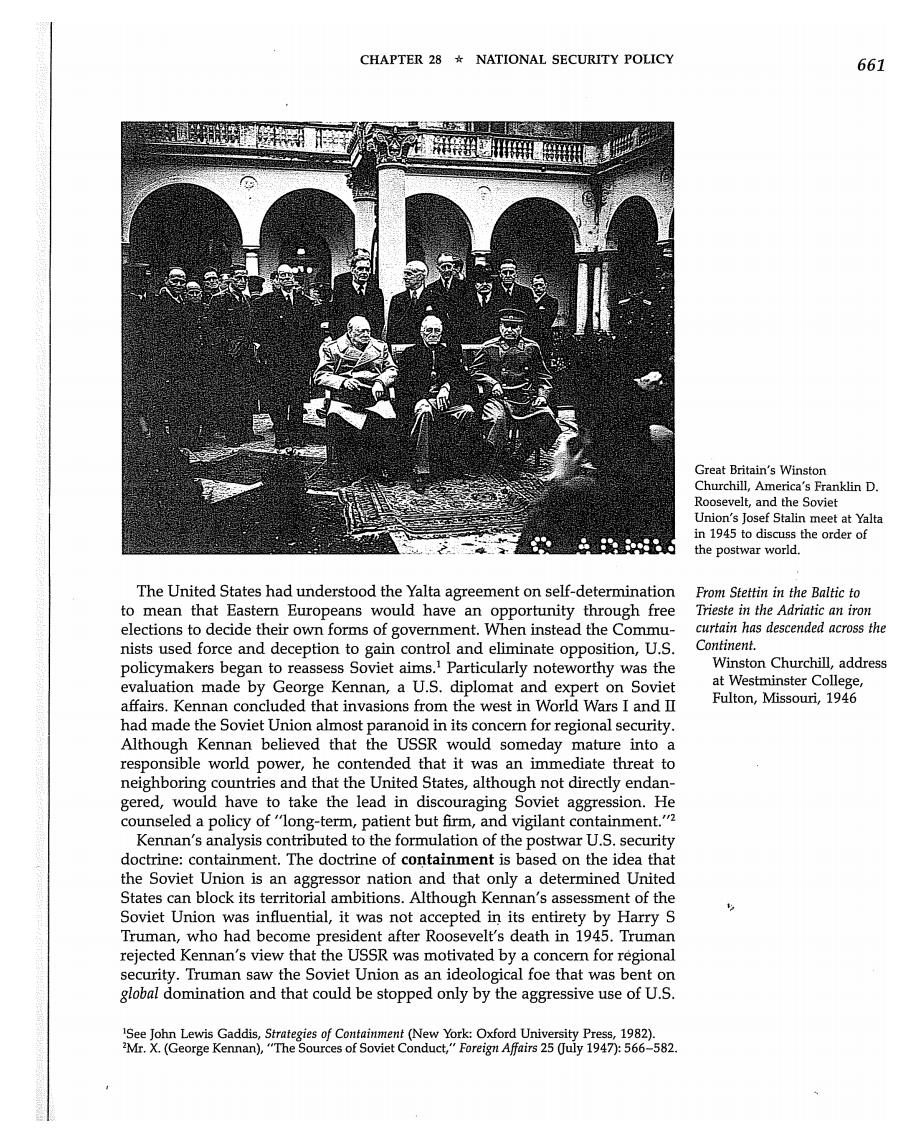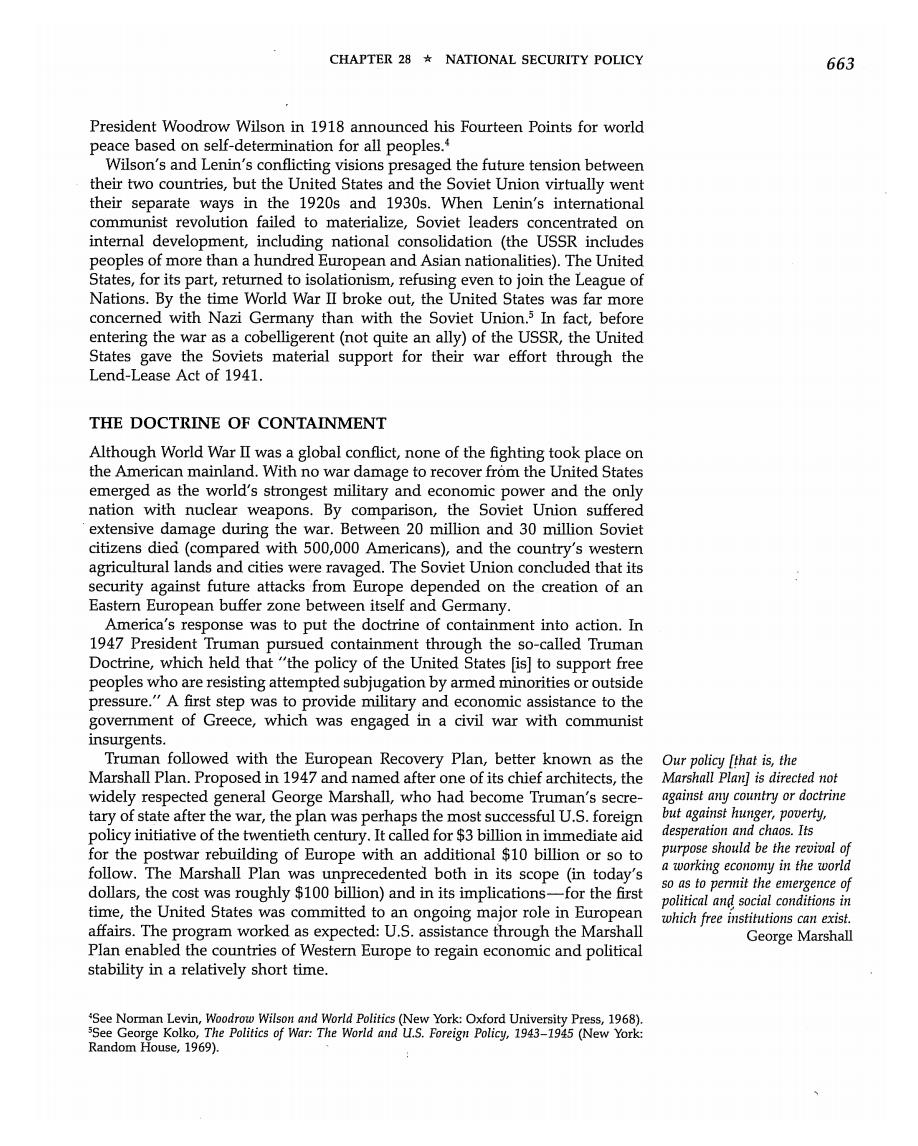
Engun 9s NATIONAL SECURITY POLICY:PROTECTING THE AMERICAN WAY We the people of the United States,in order to...provide for the common defense... -Preamble,U.S.Constitution n late spring of 1989,the West German government announced its interest in La rapid and sharp reduction in the number of battlefield nuclear weapons in Europe.The policy had been proposed by Soviet leader Mikhail Gorbachev, and opinion polls indicated that the idea was very popular among West Germans.However,the Bush administration held a different view.President George Bush had personally said that a cautious approach to European arms reductions was the only prudent course,and his secretary of state,James Baker, warned West German officials that they were playing into Gorbachev's hand by rushing to accept his idea.The Soviets'long-range plans,Baker argued included an effort to undermine the will of Western European peoples and thereby to drive a wedge into the unity that had prevailed between the United States and its European allies.The national security of the U.S.and its allies, Baker claimed,was inseparable and could be properly maintained only by a unified alliance led by the United States. National security is unlike other areas of government policy because it rests on relations with powers outside rather than within a country.There is no governmental authority to settle disputes between nations,unlike the case when disputes occur within a country.As a result,the chief instruments of national security policy-diplomacy,economic exchange,and military force-differ from those of domestic policy.President Bush had no choice but to hope that persuasion would convince the West Germans to change their position.He had no authority to order them to do so. 659

660 PART SEVEN PUBLIC POLICY The national security policy of the United States embraces an extraordinary array of activities-so many,in fact,that they could not possibly be addressed adequately in an entire book,much less a single chapter of one.There are some 160 countries in the world,and the United States has relations of one kind or another-military,diplomatic,and economic-with all of them.This chapter narrows the subject of national security policy by focusing on a variety of general issues,including U.S.defense doctrine,nuclear strategy,Third World insurgencies,the military-industrial complex,international markets,and the threat that world insecurity poses to American values. The primary goal of U.S.national security policy is preservation of the American state.This objective requires military preparedness in order to protect the territorial integrity of the United States.But the American state is more than a physical entity;it is also an economic way of life and a political idea.As a consequence,national security is an issue of economics and ideals as well as an issue of defense forces.The main ideas discussed in this chapter are the following: *Since World War II,the LInited States has pursued a policy of containment toward the Soviet Union.This policy is based on the presumption that the USSR is an aggressor country committed to a strategy of global domination.Containment policy has taken different forms at different times and was modified substantially in the 1970s by a period of detente. The United States maintains a high degree of defense preparedness.Such preparedness mandates a substantial level of defense spending and a worldwide deployment of U.S.conventional and strategic forces.A consequence of these requirements is a military-industrial complex that benefits from and is a cause of high levels of military spending. Changes in the international marketplace have led to increased economic interdependence among nations,which has had a marked influence on the United States'economy and on its security planning.Economic conditions are also a root cause of Third World insurgen- cies,which pose a "no-win"problem for U.S.interests abroad. Superpower Conflict:Contending with the Soviet Union U.S.national security policy since World War II has focused on a concern with the power and intentions of the Soviet Union.At the Yalta Conference in 1945, U.S.President Franklin Roosevelt and Soviet leader Josef Stalin had agreed that Eastern European nations were entitled to self-determination within a Soviet zone of influence,which Stalin took to mean governments aligned closely with the Soviet Untion.After the war,Soviet occupation forces assisted the Commu- nist parties of Eastern European nations to capture state power,usually by coercive means.Poland,East Germany,Hungary,Bulgaria,Albania,the Baltic states,and Yugoslavia came under communist control.In 1948 the Soviet Union completed its domination of Eastern Europe by engineering an internal coup in Czechoslovakia which ousted its democratically elected leadership.In the words of Britain's wartime prime minister,Winston Churchill,an"iron curtain" had fallen across Europe

CHAPTER 28*NATIONAL SECURITY POLICY 661 Great Britain's Winston Churchill,America's Franklin D. Roosevelt,and the Soviet Union's Josef Stalin meet at Yalta in 1945 to discuss the order of the postwar world. The United States had understood the Yalta agreement on self-determination From Stettin in the Baltic to to mean that Eastern Europeans would have an opportunity through free Trieste in the Adriatic an iron elections to decide their own forms of government.When instead the Commu- curtain has descended across the nists used force and deception to gain control and eliminate opposition,U.S. Continent. policymakers began to reassess Soviet aims.Particularly noteworthy was the Winston Churchill,address evaluation made by George Kennan,a U.S.diplomat and expert on Soviet at Westminster College, affairs.Kennan concluded that invasions from the west in World Wars I and II Fulton,Missouri,1946 had made the Soviet Union almost paranoid in its concern for regional security. Although Kennan believed that the USSR would someday mature into a responsible world power,he contended that it was an immediate threat to neighboring countries and that the United States,although not directly endan- gered,would have to take the lead in discouraging Soviet aggression.He counseled a policy of"long-term,patient but firm,and vigilant containment."2 Kennan's analysis contributed to the formulation of the postwar U.S.security doctrine:containment.The doctrine of containment is based on the idea that the Soviet Union is an aggressor nation and that only a determined United States can block its territorial ambitions.Although Kennan's assessment of the Soviet Union was influential,it was not accepted in its entirety by Harry S Truman,who had become president after Roosevelt's death in 1945.Truman rejected Kennan's view that the USSR was motivated by a concern for regional security.Truman saw the Soviet Union as an ideological foe that was bent on global domination and that could be stopped only by the aggressive use of U.S. See John Lewis Gaddis,Strategies of Containment(New York:Oxford University Press,1982). 2Mr.X.(George Kennan),"The Sources of Soviet Conduct,"Foreign Affairs 25 (July 1947):566-582

662 PART SEVEN*PUBLIC POLICY power.Like other U.S.policymakers of the postwar period,Truman accepted the notion that"appeasement"would only encourage Soviet aggression.This lesson was derived from territorial concessions made by Britain and France in 1938 to Germany's Adolf Hitler;rather than appeasing Hitler,these concessions convinced him that Germany could bully its way to further gains.Thus efforts at appeasement propelled Europe toward World War II. Truman's view became the basis of the thinking of most U.S.policymakers during the ensuing four decades.U.S.national security policy cannot be understood apart from a fear of the Soviet Union. THE HISTORICAL ROOTS OF U.S.-SOVIET CONFLICT The origins of the U.S.-Soviet conflict lie deep in history.Each country's development set it on a course that was almost certain to lead eventually to a clash with the other. During the nineteenth century,the United States played a relatively small role in world affairs because of its geographical separation from Europe and its preoccupation with internal development.The major U.S.foreign policy declaration during that century,the Monroe Doctrine (1823),warned the European powers to stay out of the Americas:"We should consider any attempt on their part to extend their system to any portion of this hemisphere as dangerous to our peace and safety."3 Ironically,at the same time that the United States was telling the European powers to forgo their territorial ambitions,it was systematically expanding into the lands of Mexico to the south and of Indian tribes to the west.Once this expansion was complete,the United States looked toward the Caribbean and Asia for additional territories,annexing Cuba,Puerto Rico,Hawaii,and the Philippine Islands. Tsarist Russia also pursued a path of expansion in the nineteenth century. Blocked to the west by stronger European powers,Russia looked eastward, toward Asia.By 1900 Russia had extended its territory to the Pacific Ocean Russia was also shedding its feudal past:Russia's rate of industrial growth during the late nineteenth century was proportionally the fastest in the world. Russia and the United States possessed huge areas of land and were rich in natural resources and thus had the capacity to overshadow the Western European powers,which were geographically much smaller.Their decline was hastened by World War I,which was waged almost entirely on the European continent. Another consequence of World War I was the collapse of tsarist Russia.The superior strength of German armies on the eastern front was a large factor in the ability of Vladimir llich Lenin's Bolshevik party to seize power in Russia.Lenin called for revolution in Europe and proposed communism as the model of a new international order.With its emphases on state ownership of economic produc- tion,material equality,armed revolution,and dictatorial leadership,Soviet communism was directly at odds with traditional American values.Americans had much earlier come to see their country as the vanguard of a new political order based on liberty,equality,and self-government.Consistent with this historical view of American exceptionalism,and in opposition to Lenin's claim, Message of President James Monroe to Congress,December 1823

CHAPTER 28*NATIONAL SECURITY POLICY 663 President Woodrow Wilson in 1918 announced his Fourteen Points for world peace based on self-determination for all peoples. Wilson's and Lenin's conflicting visions presaged the future tension between their two countries,but the United States and the Soviet Union virtually went their separate ways in the 1920s and 1930s.When Lenin's international communist revolution failed to materialize,Soviet leaders concentrated on internal development,including national consolidation (the USSR includes peoples of more than a hundred European and Asian nationalities).The United States,for its part,returned to isolationism,refusing even to join the League of Nations.By the time World War II broke out,the United States was far more concerned with Nazi Germany than with the Soviet Union.5 In fact,before entering the war as a cobelligerent(not quite an ally)of the USSR,the United States gave the Soviets material support for their war effort through the Lend-Lease Act of 1941. THE DOCTRINE OF CONTAINMENT Although World War II was a global conflict,none of the fighting took place on the American mainland.With no war damage to recover from the United States emerged as the world's strongest military and economic power and the only nation with nuclear weapons.By comparison,the Soviet Union suffered extensive damage during the war.Between 20 million and 30 million Soviet citizens died(compared with 500,000 Americans),and the country's western agricultural lands and cities were ravaged.The Soviet Union concluded that its security against future attacks from Europe depended on the creation of an Eastern European buffer zone between itself and Germany. America's response was to put the doctrine of containment into action.In 1947 President Truman pursued containment through the so-called Truman Doctrine,which held that"the policy of the United States [is]to support free peoples who are resisting attempted subjugation by armed minorities or outside pressure."A first step was to provide military and economic assistance to the government of Greece,which was engaged in a civil war with communist insurgents. Truman followed with the European Recovery Plan,better known as the Our policy [that is,the Marshall Plan.Proposed in 1947 and named after one of its chief architects,the Marshall Plan]is directed not widely respected general George Marshall,who had become Truman's secre- against any country or doctrine tary of state after the war,the plan was perhaps the most successful U.S.foreign but against hunger,poverty, policy initiative of the twentieth century.It called for $3 billion in immediate aid desperation and chaos.Its for the postwar rebuilding of Europe with an additional $10 billion or so to purpose should be the revival of follow.The Marshall Plan was unprecedented both in its scope (in today's a working economy in the world dollars,the cost was roughly $100 billion)and in its implications-for the first so as to permit the emergence of time,the United States was committed to an ongoing major role in European political and social conditions in which free institutions can exist. affairs.The program worked as expected:U.S.assistance through the Marshall George Marshall Plan enabled the countries of Western Europe to regain economic and political stability in a relatively short time. See Norman Levin,Woodrow Wilson and World Politics(New York:Oxford University Press,1968) sSee George Kolko,The Politics of War:The World and U.S.Foreign Policy,1943-1945(New York: Random House,1969)